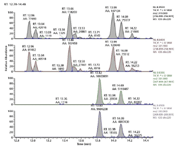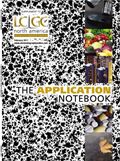PCDD/F Screening at the Maximum Residue Level for Food Safety Analysis Using Highly Selective Triple Quadrupole GC–MS-MS
The method described employs a triple quadrupole mass spectrometer equipped with hyperbolic quadrupole rods for increased selectivity to prerform a trace level screening method for PCDD/Fs and PCBs and follows the well-established United States Environmental Protection Agency (US EPA) Method 1613A.
Dirk Krumwiede and Hans-Joachim Huebschmann, Thermo Fisher Scientific
The method described employs a triple quadrupole mass spectrometer equipped with hyperbolic quadrupole rods for increased selectivity to prerform a trace level screening method for PCDD/Fs and PCBs and follows the well-established United States Environmental Protection Agency (US EPA) Method 1613A by using isotope dilution quantitation with 13 C labeled internal standards.
Polychlorinated dioxins (PCDDs/PCDFs) and polychlorinated biphenyls (PCBs) are significant food safety concerns. Performance requirements of applied analytical methods are regulated by providing identification points to analytical techniques and their combinations (1). This GC–MS-MS technique provides an instrumental screening method offering five identification points when measuring two precursor ions with one product ion each.
Experimental Conditions
The optimization of the electron energy is critical in dioxin detection. On the Thermo Scientific TSQ Quantum XLS the optimum electron energy was determined with 40 eV for optimum sensitivity. The measurement protocol followed the U.S. EPA Method 1613A with all required 13 C labeled internal standards. For data acquisition using the TSQ SRM mode, the two most intense ions of the molecular chlorine isotope cluster of each congener and internal standard were chosen, as described in referenced reports (2,3). The multiple reaction monitoring sequence (MRM) was setup using retention time segments covering the congener elution of different chlorination degrees. The acquisition of the different chlorination degrees is programmed most efficiently by using the sequential SRM mode. Only five segments are programmed to cover the relevant congeners and internal standards.
Results
The TSQ Quantum XLS facilitates the screening and quantitation of polychlorinated dioxins, furans, and PCBs at low levels in difficult matrix samples and provides results with high certainty. The added 13 C-labeled internal standard components can be detected with high reliability. The TSQ Quantum XLS with its unique hyperbolic quadrupole technology offers superior and uniform selectivity for low level dioxin and PCB samples in different complex matrices. See Figure 1 for analysis of fish sample.

Figure 1: Tetradioxin from a fish sample extract, 1 µL injected. Top traces: major native peaks show mid fg range concentrations (200â300 fg tcdd). Bottom traces: labeled internal standards recovery and surrogate.
Screening results must be verified by a confirmatory method of analysis typically by high resolution mass spectrometry (HRMS) (2). Modern HRMS systems as the Thermo Scientific DFS high resolution GC–MS are capable of providing confirmatory results down to the very low fg level.
Conclusions
The Thermo Scientific TSQ Quantum XLS facilitates the screening and quantitation of polychlorinated dioxins, furans, and PCBs, at low levels in difficult matrix samples and provides results with high certainty. The proposed MS-MS measurement scheme using two precursor ions with detection of two congener specific product ions is a valuable solution for screening for dioxins/furans and dl-PCBs at relevant MRL levels. For the fast control of food samples, GC–MS-MS with the TSQ Quantum XLS offers five identification points, exceeding the EU directive's required minimum of four identification points. With high matrix selectivity and trace level sensitivity, the TSQ Quantum XLS provides a productive and economical screening solution with high sample throughput.
References
(1) COMMISSION DECISION of 12 August 2002 implementing Council Directive 96/23/EC, Official Journal of the European Communities, L 221/8, 17.8.2002.
(2) D. Krumwiede and H.J. Huebschmann, "Confirmation of Low Level Dioxins and Furans in Dirty Matrix Samples using High Resolution GC/MS," Application Note 30112, Thermo Fisher Scientific, Bremen, Germany, 2008.
(3) D. Krumwiede and H.J. Huebschmann, "Analysis of PCBs in Food and Biological Samples Using GC Triple Quadrupole GC-MS/MS," Application Note 10262, Thermo Fisher Scientific, Bremen, Germany, 2008.
Thermo Fisher Scientific
Hanna-Kunath-Strasse 11
28199 Breman, Germany
Website: www.thermoscientific.com

Analytical Challenges in Measuring Migration from Food Contact Materials
November 2nd 2015Food contact materials contain low molecular weight additives and processing aids which can migrate into foods leading to trace levels of contamination. Food safety is ensured through regulations, comprising compositional controls and migration limits, which present a significant analytical challenge to the food industry to ensure compliance and demonstrate due diligence. Of the various analytical approaches, LC-MS/MS has proved to be an essential tool in monitoring migration of target compounds into foods, and more sophisticated approaches such as LC-high resolution MS (Orbitrap) are being increasingly used for untargeted analysis to monitor non-intentionally added substances. This podcast will provide an overview to this area, illustrated with various applications showing current approaches being employed.

















